What Were 2014's Top Medtech Products and Services?
October 15, 2014
We are looking to our readers to help pick the top products and services of the year. Vote on the products below, which have been featured either on Qmed on in the MPMN print magazine this year, or nominate a new product or service.
Part Measurement System
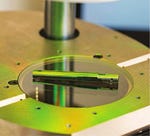 Featured on the cover of the 2014 January/February issue of MPMN, the Snap one-button measurement system from RAM Optical Instrumentation Inc., a division of Quality Vision International, is designed for the fast, accurate measurement of small manufactured parts. The system's telecentric optics and 78-mm field of view enable users to verify the critical dimensions and features of a range of medical devices, such as orthopedic bone plates and screws, multipocketed suturing devices, and various prosthetic implants. A proprietary high-resolution digital camera with digital zoom provides high-definition video images
Featured on the cover of the 2014 January/February issue of MPMN, the Snap one-button measurement system from RAM Optical Instrumentation Inc., a division of Quality Vision International, is designed for the fast, accurate measurement of small manufactured parts. The system's telecentric optics and 78-mm field of view enable users to verify the critical dimensions and features of a range of medical devices, such as orthopedic bone plates and screws, multipocketed suturing devices, and various prosthetic implants. A proprietary high-resolution digital camera with digital zoom provides high-definition video images
RAM Optical Instrumentation Inc., div. of Quality Vision International
Rochester, NY
www.ramoptical.com
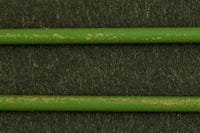
Guidewire Coating Service
Chicago-based Surface Solutions Group has come up with a method to keep PTFE to stick to stainless steel wires, which has proven to be a challenge after the EPA required manufacturers to eliminate the suspected carcinogen perfluorooctanoic acid from their PTFE formulations by 2015.
Surface Solutions Group
Chicago, IL
www.surfacesolutionsgroup.com
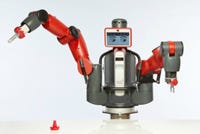
The Baxter Collaborative Robot
The two-armed Baxter robot from Rethink Robotics may not yet be a staple in the medtech industry yet, but it is finding a growing user base in the sector, according to its manufacturer. Baxter has a low price tag and can collaborate with humans and can be programmed to perform basic assembly tasks in minutes. The robot's capabilities have expanded significantly this year with advances in its software. In addition, Baxter could help companies interesting in moving away from offshoring production move production back to the United States.
Rethink Robotics
Boston
www.rethinkrobotics.com
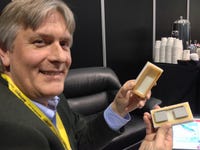
A Really Tiny Reed Switch
Coto Technology is ramping up production in May of a microelectromechanical systems (MEMS) reed switch that is only about 1-by-1 mm in size. But what would it be good for in the medical device field? The answer turns out to be a lot, William Gotschewski, vice president of sales and marketing at Coto, told MPMN at BIOMEDevice Boston. Because the reed switch only responds to magnetic fields coming from specific directions, it can ensure that a device such as an insulin pump doesn't accidently discharge insulin if a diabetic, say, is using a power drill emitting its own magnetic field, Gotschewski said.
Coto Technology
North Kingstown, RI
www.cotorelay.com
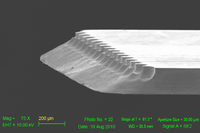 Super-Robust Surgical Blades
Super-Robust Surgical Blades

Hutchinson Technology, which was long a maker of computer disk suspensions, is leveraging its manufacturing expertise to produce thousands of tiny stainless-steel surgical blades less than an inch in length, about the same size as the disk suspensions that had long been Hutchinson's bread and butter. An undisclosed major medical device company recently received FDA approval for a surgical device that uses Hutchinson's blades, and the company is working on securing more major customers, says Dan Roach, business development manager at Hutchinson.
Hutchinson Technology
Hutchinson, MN
www.htch.com
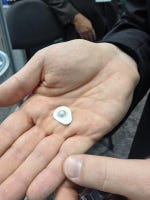 Next-Generation Blister Packaging
Next-Generation Blister Packaging

J-Pac Medical is finding a growing number of applications for its blister packaging technology, even reinventing it to hold a reagent for a diagnostic application. The company often collaborates with medical device clients to come up with custom packaging.
The firm notes that they are seeing greater demand from device companies looking to collaborate on design of products as well. "Everything from early stage design to delivery of the finished product is being pushed to suppliers like J-Pac Medical," said Jeffrey Koslosky, J-Pac's vice president of marketing and business development, earlier this year.
J-Pac Medical
Somersworth, NH
www.j-pacmedical.com
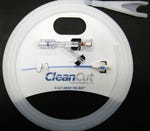 A Novel Catheter and Guidewire Dispenser
A Novel Catheter and Guidewire Dispenser

CleanCut Technologies (Anaheim, CA) has developed an innovative dispenser known as the DISK, or dispenser integrated system kit, that combines two products--a clipless dispenser for catheters and guidewires, and a die-cut backer card--into one. The idea for the original dispenser was born about 13 years ago in response to a client's desire for a better dispenser for catheters and guidewires. Conventional dispensers designed with clips to hold the tubing together have several shortcomings, according to Bell. The clips can cause a puncture in a sterile pouch, for example, which compromises product safety.
CleanCut Technologies
Anaheim, CA
www.cleancuttek.com
 Micro Medical Fibers
Micro Medical Fibers

Whether it's computers, cardiovascular devices, or engineered polymers, tinier is the way to go these days. Add medical grade fibers from Windsor, CA-based RxFiber to the list, too. The company has developed a high-tenacity polyester fibers that can be measured in the microns--selling the microfibers to undisclosed medical device companies developing increasingly small devices. Whether it's endovascular stents or transcatheter heart valves, medical device companies are striving for lumens as small as 14 or 16 Fr, versus the previous 25.
RxFiber
Windsor, CA
www.rxfiber.com
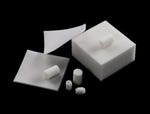 Nanoscale Material
Nanoscale Material

Biomerix Corp. has developed a porous polyurethane material suitable for a variety of vascular applications. Such biodegradable scaffolds could be used for cartilage repair; plugging holes from natural orifice translumenal endoscopic (NOTES) surgery; and delivery of useful drugs or biologics to internal tissues. The material is the result of Biomerix taking a stiff form of polyurethane and turning it into something that would be elastomeric--able to hold up its properties while squished inside a endoscopic surgical device, expanded to fit wherever it needed to go, or stretched or squished inside a moving human body.
Biomerix Corp.
Fremont, CA
www.biomerix.com
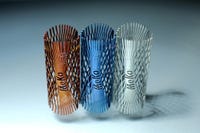 Laser-Processing Services
Laser-Processing Services

MeKo (Sarstedt, Germany) specializes in providing medical device manufacturers with high-precision metal processing performed using laser technology in accordance with the ISO 13485 standard. The company claims it can maintain tolerances of ±0.0002 in. when laser-cutting stents, cardiac valves, and other medical components, and it laser-drills holes with standard diameters as small as 0.0001 in.
MeKo
Sarstedt, Germany
www.meko.de/en/medical
Qualcomm's 2Net Hub
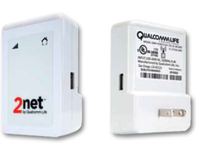 Qualcomm has announced that its 2net Hub, the company's plug-and-play home gateway for health monitoring devices, has become one of the first hubs that is both an FDA Class I medical device and is able to communicate with devices over Bluetooth Smart. Adopting the new Bluetooth format was apparently an easy decision for Qualcomm. More than 90% of the medical device makers Qualcomm is working with are either launching or planning to launch the next iteration of their devices as Bluetooth Low Energy, Chris Talbot senior director of business development at Qualcomm Life, told Qmed earlier this year.
Qualcomm has announced that its 2net Hub, the company's plug-and-play home gateway for health monitoring devices, has become one of the first hubs that is both an FDA Class I medical device and is able to communicate with devices over Bluetooth Smart. Adopting the new Bluetooth format was apparently an easy decision for Qualcomm. More than 90% of the medical device makers Qualcomm is working with are either launching or planning to launch the next iteration of their devices as Bluetooth Low Energy, Chris Talbot senior director of business development at Qualcomm Life, told Qmed earlier this year.
Qualcomm Life
San Diego, CA
www.qualcommlife.com
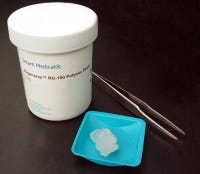 Novel Biomaterial
Novel Biomaterial

Secant Medical's PGS biomaterial is stretching the old biomaterial paradigms, providing an alternative to the poly lactic acid, poly glycolic acid, poly caprolactone, and poly dioxanone that had previously dominated that biomaterials space for decades. From its inception, this material has been gifted with broken paradigms. It was invented by the highly acclaimed scientist and MDEA Lifetime Achievement Award winner Dr. Robert Langer, and his post-doctoral assistant, Dr. Yadong Wang, both of whom understand the challenges associated with commercializing biomaterials. From there it was taken up and licensed by a company, Secant Medical, which understands all the risks associated with selling the material and creating the market for it, but is not paralyzed by the daunting task.
Secant Medical
Perkasie, PA
www.secantmedical.com
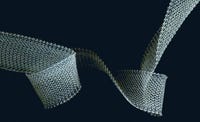 Absorbable Biomaterial Technology
Absorbable Biomaterial Technology

TissueGen's Elute biodegradable fiber products, which encompass common biodegradable polymers, can be used to direct nerve regrowth in the body. "What we bring to the board is the ability to take standby materials and load drug into them and, within that standardized format, tailor the release kinetics," says chief scientific officer Kevin Nelson. "We can achieve what we do by simply making alterations in either the porosity of the fiber or in the degree of interaction that the excipient has with the surrounding polymer matrix. With those two basic variables, we can change the release kinetics of the drug significantly."
TissueGen
Dallas, TX
www.tissuegen.com
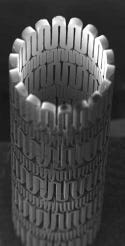 High Resolution Laser Machining
High Resolution Laser Machining

Super-fast, fiber-based lasers have a number of advantages for the medical device industry. "When you cut a metal stent with YAG laser, ... you have to go through a grinding, polishing phase afterwards. ... With the new lasers, you're done. No cleaning afterwards. ... There's no slag. There's no debris. It's ready to go," says Glenn Ogura, executive vice president at laser machining contract manufacturer Resonetics.
Ogura thinks every new enabling technology needs a "killer app" that allows it be widely used. Excimer lasers, for example, found their application in high-density computer chips.
"I think bioabsorbable stents are going to be the killer app," Ogura says of the super-fast lasers.
Resonetics
Nashua, NH
www.resonetics.com
About the Author(s)
You May Also Like

.png?width=300&auto=webp&quality=80&disable=upscale)
